Evaluation of Future Maize Yield Changes and Adaptation Strategies in China
Abstract
:1. Introduction
2. Materials and Methods
2.1. Data
2.2. Simulation of Maize Yield Using DSSAT
2.3. Bias Correction
3. Results
3.1. Climate Change under Global Warming
3.2. Yield Changes of Maize under Future Scenarios
3.3. Impacts of Different Adaptation Strategies on Maize Yield
3.3.1. Adjustment of Sowing Date
3.3.2. Varieties Adjustment
4. Discussion and Conclusions
4.1. Discussion
4.2. Conclusions
Author Contributions
Funding
Institutional Review Board Statement
Informed Consent Statement
Data Availability Statement
Conflicts of Interest
References
- IPCC. Summary for Policymakers. In Climate Change 2022: Impacts, Adaptation and Vulnerability. Contribution of Working Group II to the Sixth Assessment Report of the Intergovernmental Panel on Climate Change; Cambridge University Press: Cambridge, UK, 2022. [Google Scholar]
- Chao, Q.C.; Zhang, Y.X.; Gao, X.; Wang, M. Paris Agreement: A new start for global governance on climate. Clim. Change Res. 2016, 12, 61–67. [Google Scholar]
- IPCC. Summary for Policymakers. In Climate Change 2021: The Physical Science Basis. Contribution of Working Group I to the Sixth Assessment Report of the Intergovernmental Panel on Climate Change; Cambridge University Press: Cambridge, UK, 2021. [Google Scholar]
- Xu, Y.L.; Zhao, Y.C.; Zhai, P.M. Advances in scientific understanding on climate change and food security from IPCC special report SRCCL. Clim. Change Res. 2020, 16, 37–49. [Google Scholar]
- Ding, R.; Shi, W.J. Quantitative evaluation of the effects of climate change on cereal yields of Tibet during 1993–2017. Acta Geogr. Sin. 2022, 32, 101–116. [Google Scholar]
- Lobell, D.B.; Schlenker, W.; Costa-Roberts, J. Climate trends and global crop production since 1980. Science 2011, 333, 616–620. [Google Scholar] [CrossRef] [PubMed] [Green Version]
- Li, Y.J.; Wang, C.Y.; Zhao, B.; Liu, W.J. Effects of climate change on agricultural meteorological disaster and crop insects diseases. Trans. CSAE 2010, 26, 263–271. [Google Scholar]
- Li, G.; Li, Y.; Huang, G.B.; Luo, Z.Z.; Wang, Q.; Liu, Q.; Yan, Z.G.; Zhao, Y.Y. The effects of climate change on Dryland wheat production under different tillage systems. Acta Prataculturae Sin. 2012, 21, 160–168. [Google Scholar]
- Cao, L.; Zhao, P.; Yan, Z.; Jones, P.; Zhu, Y.; Yu, Y.; Tang, G. Instrumental temperature series in eastern and central China back to the nineteenth century. J. Geophys. Res. Atmos. 2013, 118, 8197–8207. [Google Scholar] [CrossRef]
- Ren, G.; Ding, Y.; Zhao, Z.; Zheng, J.; Wu, T.; Tang, G.; Xu, Y. Recent progress in studies of climate change in China. Adv. Atmos. Sci. 2012, 29, 958–977. [Google Scholar] [CrossRef]
- IPCC. Climate Change 2014: Impacts, Adaptation, and Vulnerability; Cambridge University Press: Cambridge, UK, 2014.
- Zhao, Y.X.; Xiao, D.P.; Tang, J.Z.; Bai, H.Z. Effects of climate change on the yield of major grain crops and its adaptation measures in China. Res. Soil Water Conserv. 2019, 26, 317–326. [Google Scholar]
- Xiao, L.J.; Liu, L.L.; Asseng, S.; Xia, Y.M.; Tang, L.; Liu, B.; Cao, W.X.; Zhu, Y. Estimating spring frost and its impact on yield across winter wheat in China. Agric. For. Meteorol. 2018, 260, 154–164. [Google Scholar]
- Yang, J.M.; Yang, J.Y.; Jiang, X. Progress of crop model research. J. Jilin Agric. Univ. 2012, 34, 553–561. [Google Scholar]
- Kocsis, M.; Dunai, A.; Mako, A.; Farsang, A.; Meszaros, J. Estimation of the drought sensitivity of Hungarian soils based on corn yield responses. J. Maps 2019, 16, 148–154. [Google Scholar] [CrossRef]
- Lobell, D.B.; Roberts, M.J.; Schlenker, W.; Braun, N.; Little, B.B.; Rejesus, R.M.; Hammer, G.L. Greater sensitivity to drought accompanies maize yield increase in the US Midwest. Science 2014, 344, 516–519. [Google Scholar] [CrossRef]
- Huang, S.; Lv, L.; Zhu, J.; Li, Y.; Tao, H.; Wang, P. Extending growing period is limited to offsetting negative effects of climate changes on maize yield in the North China Plain. Field Crops Res. 2018, 215, 66–73. [Google Scholar] [CrossRef]
- Lv, S.; Yang, X.G.; Zhao, J.; Liu, Z.J.; Li, K.N.; Mu, C.Y.; Chen, X.C.; Chen, F.J.; Mi, G.H. Effects of climate change and variety alternative on potential yield of spring maize in Northeast China. Trans. Chin. Soc. Agric. Eng. 2013, 29, 179–190. [Google Scholar]
- Li, K.; Xiong, W.; Pan, J.; Lin, E.; Li, Y.; Han, X. Trend evaluation on changes of maize yield in China under global warming by 1.5 °C and 2 °C. Chin. J. Agrometeorol. 2018, 39, 765–777. [Google Scholar]
- Li, M.-Y.; Gao, X.-N.; Pan, J.; Xiong, W.; Guo, L.-P.; Lin, E.-D.; Li, K. Possible trends of rice yield in China under global warming by 1.5 °C and 2.0 °C. J. Nat. Resour. 2021, 36, 567–581. [Google Scholar] [CrossRef]
- Lobell, D.B.; Burke, M.B. On the use of statistical models to predict crop yield responses to climate change. Agric. For. Meteorol. 2010, 150, 1443–1452. [Google Scholar] [CrossRef]
- Ma, Y.L.; Wang, Z.W.; Luan, Q.; Hu, L.W.; Zhang, A.Z. Relation between maize yield and eco-climate factors. Chin. J. Agrometeorol. 2009, 30, 565–568. [Google Scholar]
- Zipper, S.C.; Qiu, J.; Kucharik, C.J. Drought effect on US maize and soybean production: Spatiotemporal patterns and historical changes. Environ. Res. Lett. 2016, 11, 094021. [Google Scholar] [CrossRef]
- Ray, R.L.; Fares, A.; Risch, E. Effects of drought on crop production and cropping areas in Texas. Agric. Environ. Lett. 2018, 3, 170037. [Google Scholar] [CrossRef] [Green Version]
- Schlenker, W.; Lobell, D.B. Robust negative impacts of climate change on African agriculture. Environ. Res. Lett. 2010, 5, 01410. [Google Scholar] [CrossRef]
- Zhao, C.; Liu, B.; Piao, S.L.; Wang, X.H.; Lobell, D.B.; Huang, Y.; Huang, M.T.; Yao, Y.T.; Bassu, S.; Ciais, P.; et al. Temperature increase reduces global yields of major crops in four independent estimates. Proc. Natl. Acad. Sci. USA 2017, 114, 9326–9331. [Google Scholar]
- Xie, L.Y.; Ma, Z.Y.; Gao, X.N.; Tong, C.F.; Lin, E.D. FACE and its limitations on researches of impacts of elevated CO2 on crops. J. China Agric. Univ. 2008, 13, 23–28. [Google Scholar]
- Zhang, Z.T.; Yang, X.G.; Gao, J.Q.; Wang, X.L.; Bai, F.; Sun, S.; Liu, Z.J.; Ming, B.; Xie, R.Z.; Wang, K.R.; et al. Analysis of suitable sowing date for summer maize in North China Plain under climate change. Sci. Agric. Sin. 2018, 51, 3258–3274. [Google Scholar]
- Cui, Y.; Jiang, S.M.; Jin, J.L.; Ning, S.W.; Feng, P. Quantitative assessment of soybean drought loss sensitivity at different growth stages based on shaped damage curve. Agric. Water Manag. 2019, 213, 821–832. [Google Scholar] [CrossRef]
- Liu, Y.J.; Ya, Q.; Ge, Q.S. Spatiotemporal Differentiation of Changes in Maize Phenology in China from 1981 to 2010. J. Geogr. Sci. 2019, 29, 351–362. [Google Scholar] [CrossRef] [Green Version]
- Zhou, L.; Pan, J.; Zhang, L.; Xu, Y.L. Analysis on statistical bias correction of daily precipitation simulated by regional climate model. J. Trop. Mereorol. 2014, 30, 137–144. [Google Scholar]
- Xu, Y.L.; Pan, J.; Feng, Q.; Lin, Y.H.; Li, K. Prediction of Future Climate Change in China-Constructing SRES High-Resolution Climate Scenarios Using PRECIS; Science Press: Beijing, China, 2016; pp. 198–200. [Google Scholar]
- Ruane, A.C.; Goldberg, R.; Chryssanthacopoulos, J. Climate forcing datasets for agricultural modeling: Merged products for gap-filling and historical climate series estimation. Agric. For. Meteorol. 2015, 200, 233–248. [Google Scholar] [CrossRef] [Green Version]
- Hoogenboom, G.; Jones, J.; Wilkens, P.; Porter, C.; Boote, K.; Hunt, L.D.; Singh, U.; Lizaso, J.I.; White, J.M.; Uryasev, O.; et al. Decision Support System for Agrotechnology Transfer (DSSAT) Version 4.6; DSSAT Foundation, Prosser: Washington, DC, USA, 2015; Available online: http://dssat.net (accessed on 30 May 2022).
- Mi, N.; Cai, F.; Zhang, S.; Zhang, Y.; Ji, R.; Chen, N.; Ji, Y.; Wang, D. Thermal Time Requirements for Maize Growth in Northeast China and Their Effects on Yield and Water Supply under Climate Change Conditions. Water 2021, 13, 2612. [Google Scholar] [CrossRef]
- Xu, F.; Wang, B.; He, C.; Liu, D.; Feng, P.; Yao, N.; Zhang, R.; Xu, S.; Xue, J.; Feng, H.; et al. Optimizing Sowing Date and Planting Density Can Mitigate the Impacts of Future Climate on Maize Yield: A Case Study in the Guanzhong Plain of China. Agronomy 2021, 11, 1452. [Google Scholar] [CrossRef]
- Koimbori, J.K.; Wang, S.; Pan, J.; Guo, L.; Li, K. Yield Response of Spring Maize under Future Climate and the Effects of Adaptation Measures in Northeast China. Plants 2022, 11, 1634. [Google Scholar] [CrossRef]
- Lin, Y.; Wu, W.; Ge, Q. CERES-Maize model-based simulation of climate change impacts on maize yields and potential adaptive measures in Heilongjiang Province, China. J. Sci. Food Agric. 2015, 95, 2838–2849. [Google Scholar] [CrossRef] [PubMed]
- Zhao, J.; Yang, X. Spatial patterns of yield-based cropping suitability and its driving factors in the three main maize-growing regions in China. Int. J. Biometeorol. 2019, 63, 1659–1668. [Google Scholar] [CrossRef]
- Yin, Y.; Tang, Q.; Liu, X. A multi-model analysis of change in potential yield of major crops in China under climate change. Earth Syst. Dyn. 2015, 6, 45–59. [Google Scholar] [CrossRef] [Green Version]

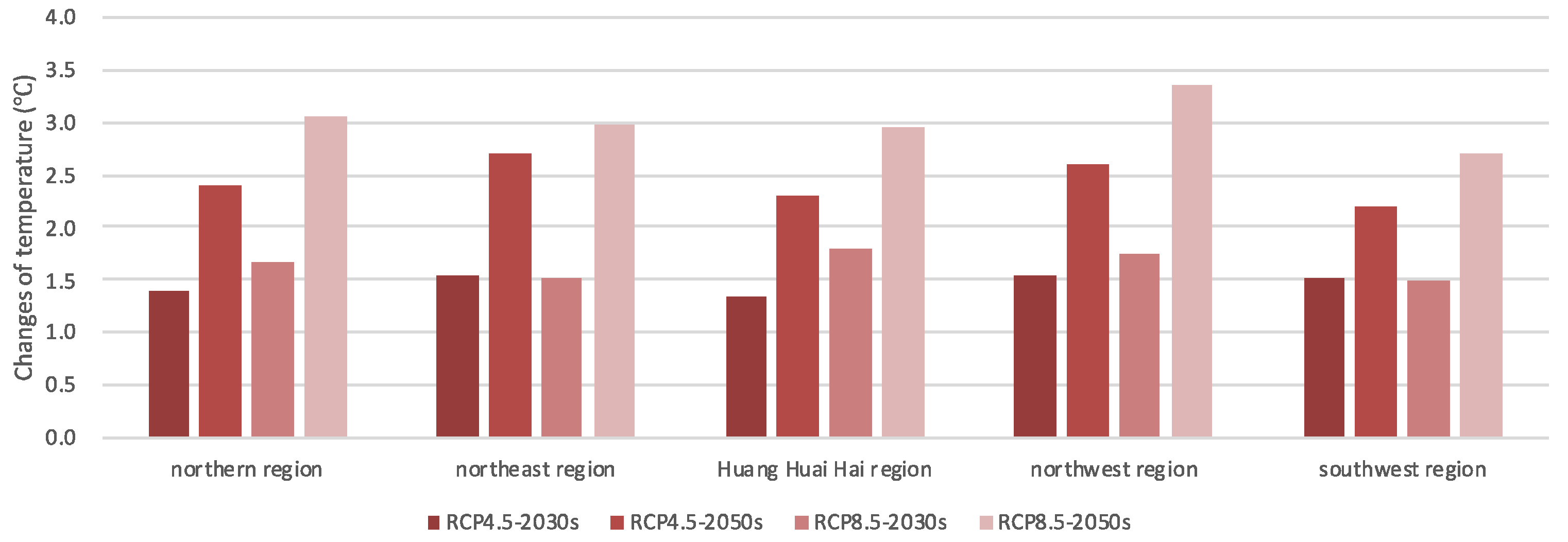
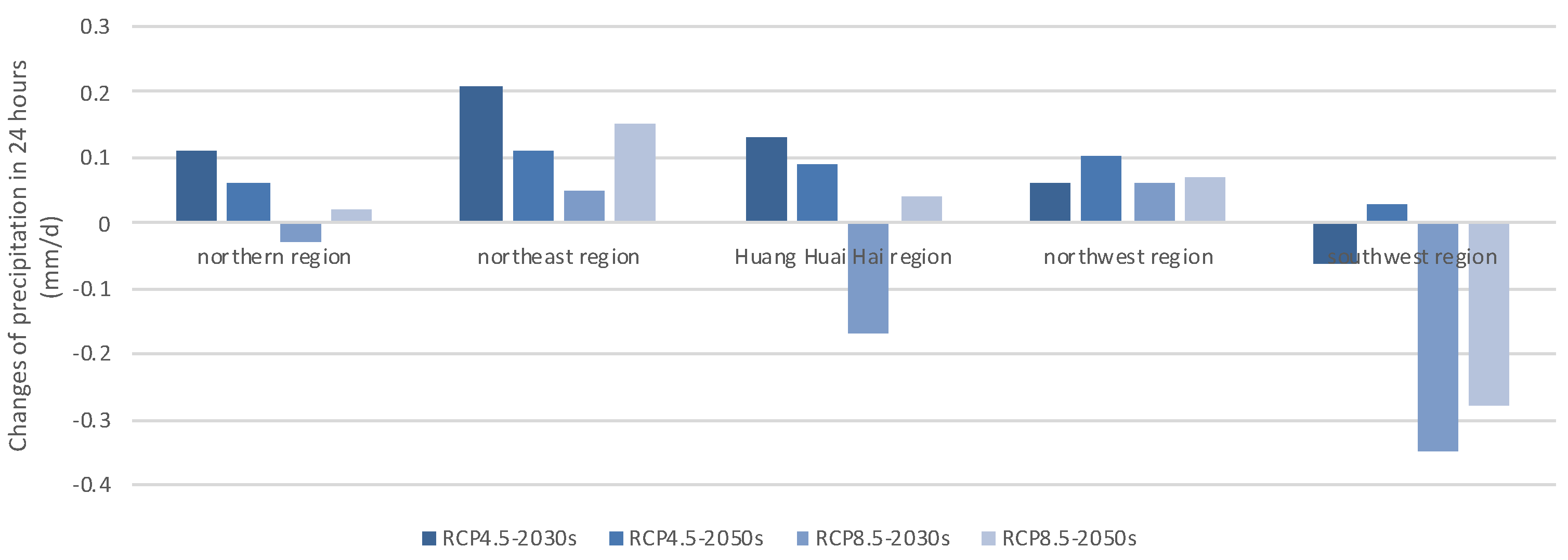

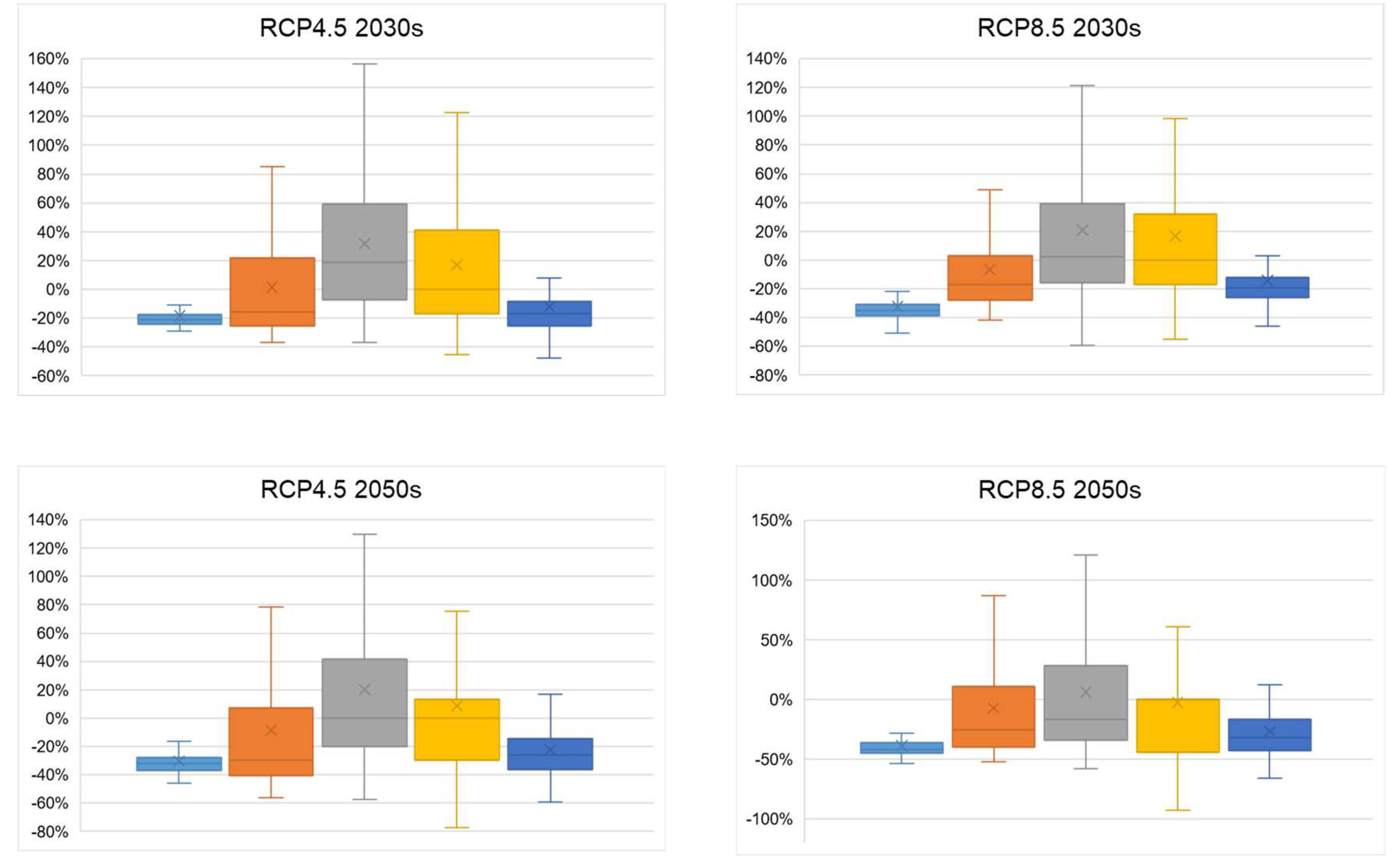
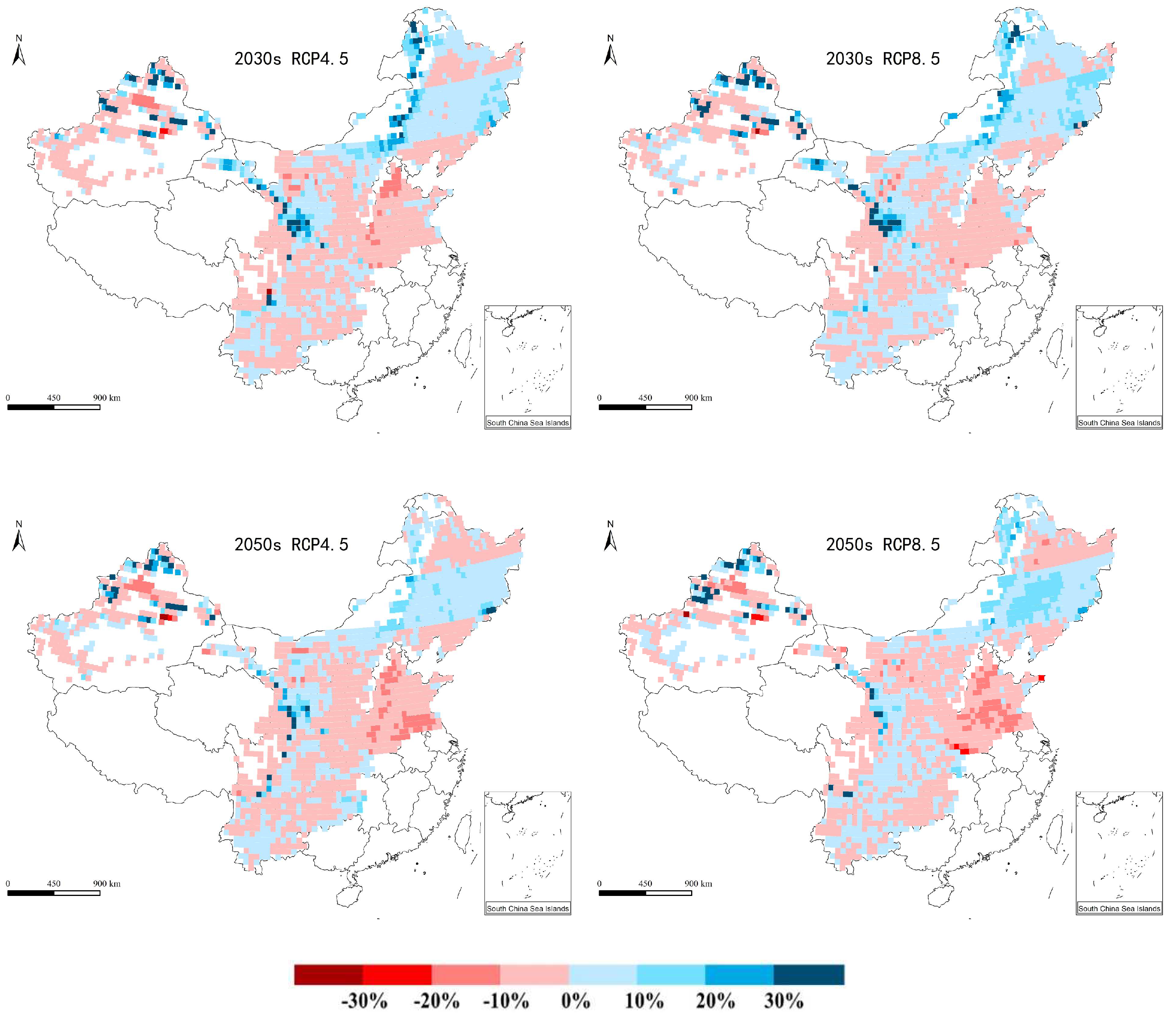
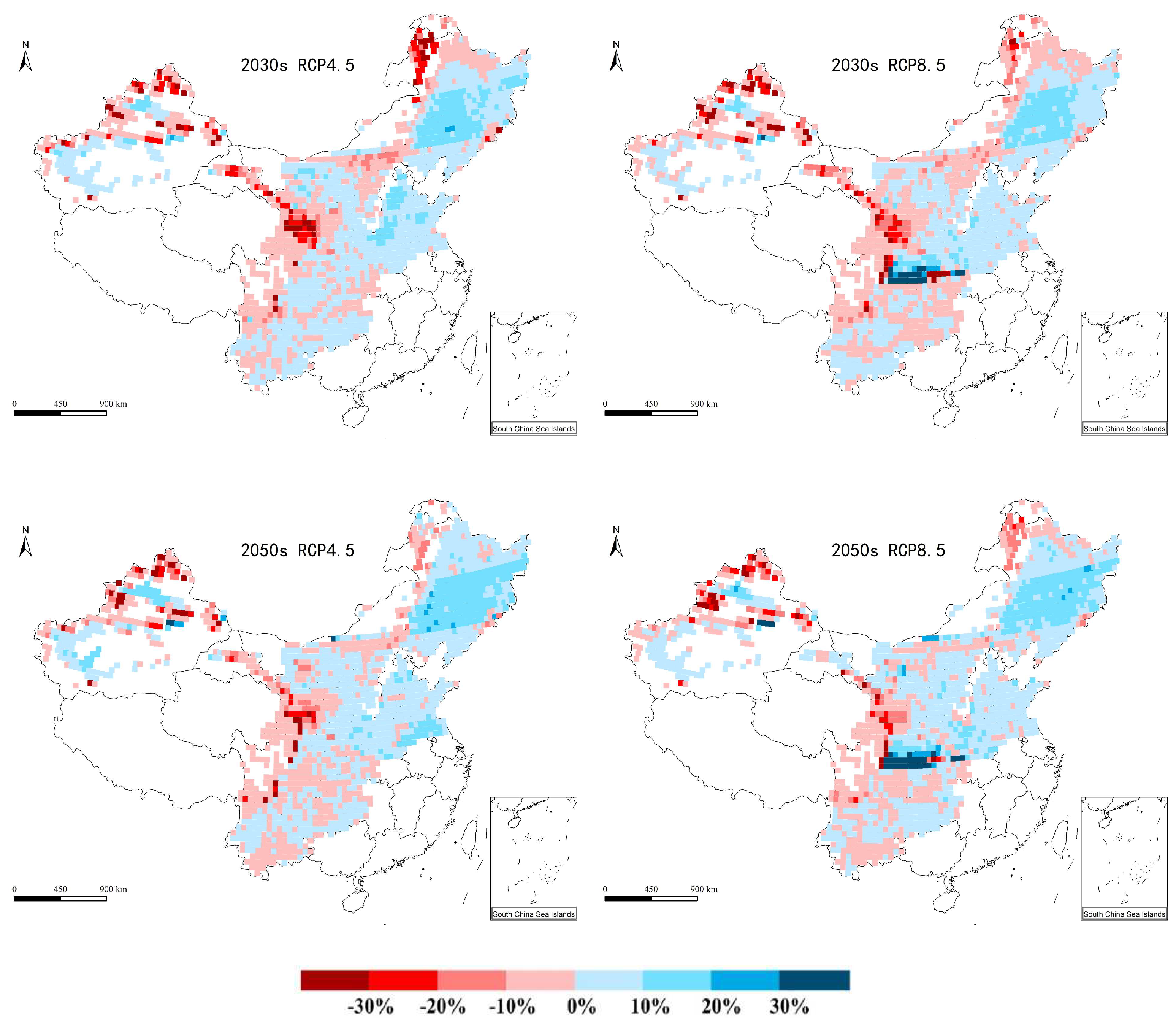
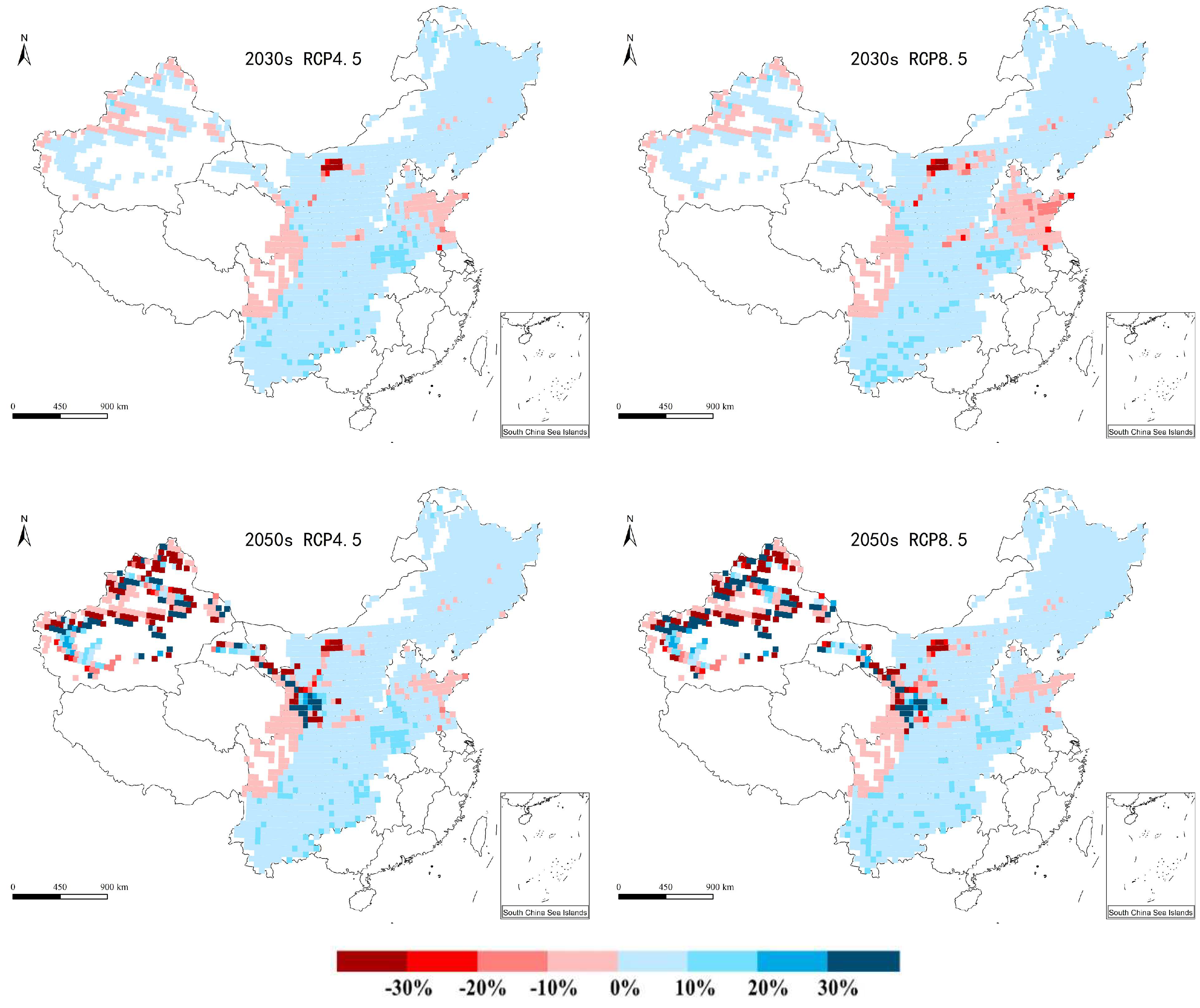

| Zones | Regions | P1 | P2 | P5 | G2 | G3 | PHINT | NRMSE | ||
|---|---|---|---|---|---|---|---|---|---|---|
| ADAP | MDAP | HWAM | ||||||||
| North zone | 1st district | 196.4 | 0.211 | 637.6 | 452.4 | 11.01 | 49 | 2.00% | 3.69% | 6.17% |
| 2nd district | 219.7 | 1.309 | 655.1 | 390.5 | 15.44 | 49 | 3.03% | 3.54% | 4.84% | |
| 3rd district | 300.6 | 1.048 | 694.6 | 518.7 | 11.31 | 49 | 1.63% | 2.95% | 5.60% | |
| 4th district | 346.8 | 0.263 | 954.4 | 570 | 7.558 | 49 | 2.45% | 4.79% | 4.81% | |
| Huang Huai Hai zone | 1st district | 216.2 | 0.650 | 675.9 | 815.1 | 10.58 | 49 | 3.22% | 3.26% | 9.32% |
| 2nd district | 205.8 | 0.645 | 646.2 | 878.5 | 12.91 | 49 | 9.05% | 6.45% | 13.97% | |
| 3rd district | 201.5 | 0.743 | 792.7 | 647.6 | 9.84 | 49 | 6.78% | 4.89% | 5.99% | |
| 4th district | 223.8 | 1.097 | 687.9 | 791.9 | 9.72 | 49 | 8.20% | 4.52% | 8.48% | |
| 5th district | 238.1 | 0.584 | 856.5 | 806.6 | 9.13 | 49 | 2.87% | 3.89% | 10.14% | |
| Northwest zone | 1st district | 417.7 | 1.317 | 687.8 | 440.4 | 11.61 | 45 | 3.68% | 3.03% | 4.22% |
| 2nd district | 443.1 | 0.444 | 780.8 | 679.2 | 12.18 | 45 | 4.61% | 4.64% | 5.71% | |
| 3rd district | 362.8 | 0.536 | 819.1 | 281.2 | 19.51 | 50 | 3.27% | 2.80% | 9.26% | |
| Southwest zone | 1st district | 388.4 | 0.674 | 746.2 | 400.0 | 11.00 | 38.9 | 3.96% | 4.53% | 7.97% |
| 2nd district | 315.0 | 0.472 | 737.0 | 340.8 | 17.00 | 38.9 | 5.45% | 5.25% | 5.20% | |
Publisher’s Note: MDPI stays neutral with regard to jurisdictional claims in published maps and institutional affiliations. |
© 2022 by the authors. Licensee MDPI, Basel, Switzerland. This article is an open access article distributed under the terms and conditions of the Creative Commons Attribution (CC BY) license (https://creativecommons.org/licenses/by/4.0/).
Share and Cite
Li, K.; Guo, L.; Pan, J.; Li, M. Evaluation of Future Maize Yield Changes and Adaptation Strategies in China. Sustainability 2022, 14, 9246. https://doi.org/10.3390/su14159246
Li K, Guo L, Pan J, Li M. Evaluation of Future Maize Yield Changes and Adaptation Strategies in China. Sustainability. 2022; 14(15):9246. https://doi.org/10.3390/su14159246
Chicago/Turabian StyleLi, Kuo, Liping Guo, Jie Pan, and Mingyu Li. 2022. "Evaluation of Future Maize Yield Changes and Adaptation Strategies in China" Sustainability 14, no. 15: 9246. https://doi.org/10.3390/su14159246
APA StyleLi, K., Guo, L., Pan, J., & Li, M. (2022). Evaluation of Future Maize Yield Changes and Adaptation Strategies in China. Sustainability, 14(15), 9246. https://doi.org/10.3390/su14159246







